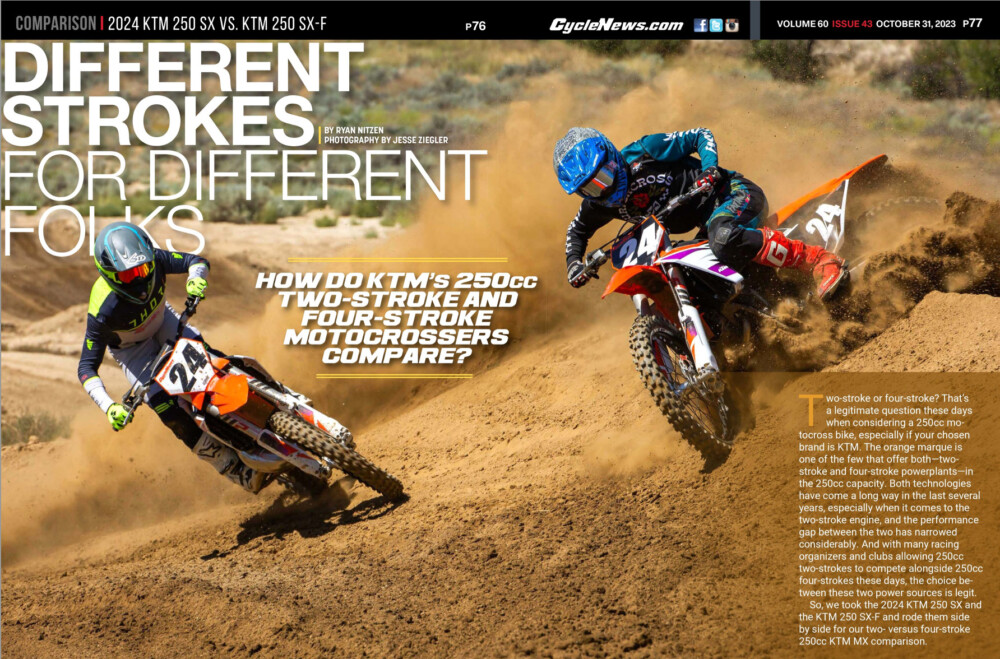Ryan Nitzen | November 1, 2023
How do KTM’s 250cc two-stroke and four-stroke motocrossers compare?
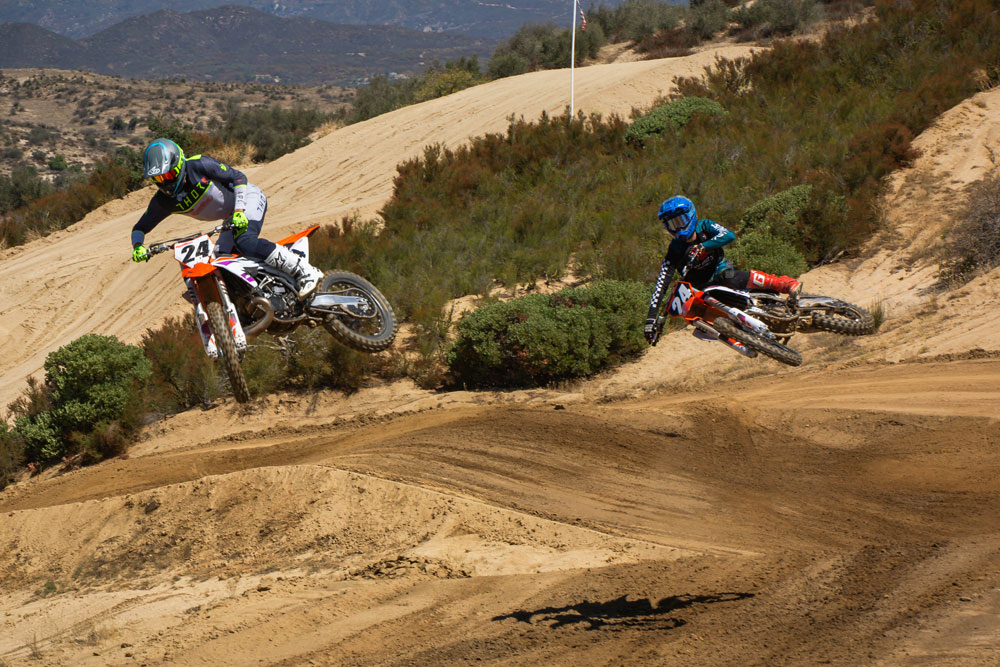
Photography by Jesse Ziegler
Two-stroke or four-stroke? That’s a legitimate question these days when considering a 250cc motocross bike, especially if your chosen brand is KTM. The orange marque is one of the few that offer both—two-stroke and four-stroke powerplants—in the 250cc capacity. Both technologies have come a long way in the last several years, especially when it comes to the two-stroke engine, and the performance gap between the two has narrowed considerably. And with many racing organizers and clubs allowing 250cc two-strokes to compete alongside 250cc four-strokes these days, the choice between these two power sources is legit.
So, we took the 2024 KTM 250 SX and the KTM 250 SX-F and rode them side by side for our two- versus four-stroke 250cc KTM MX comparison.
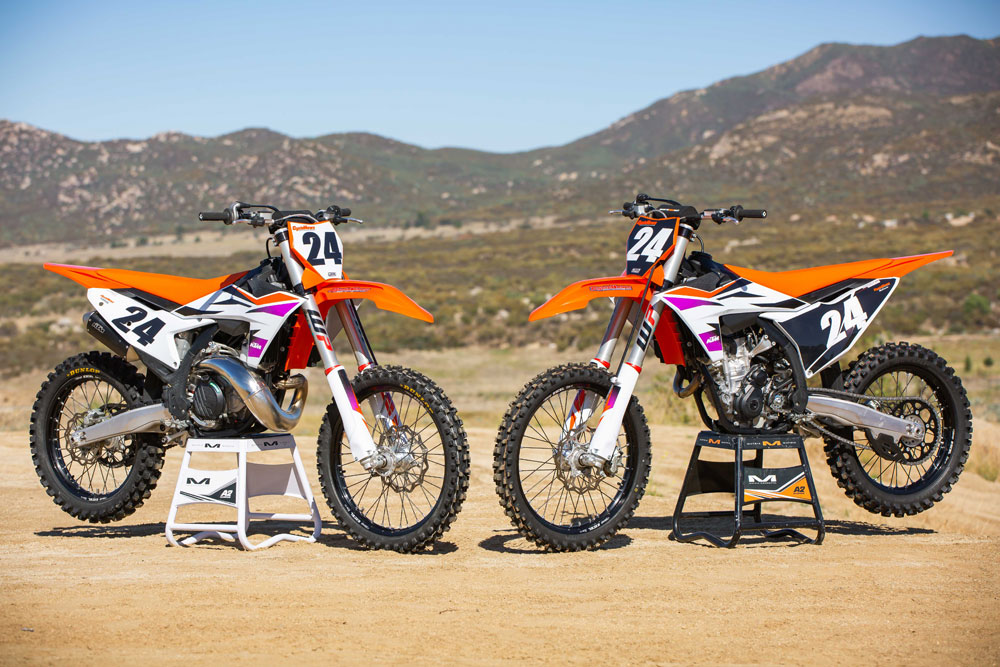 The 250 SX-F and the 250 SX are more similar than you might think.
The 250 SX-F and the 250 SX are more similar than you might think.
KTM Two-Stroke
The KTM 250 SX two-stroke received a ground-up redesign in 2023 and is unchanged for the 2024 model year. KTM breathed new life into the SX in ’23, with the bike seeing an entirely new engine equipped with throttle body fuel injection (TBI), an electronic power-valve and two different mapping options. A new chassis and bodywork house the powerplant, sharing the same one used on its four-stroke counterpart. Updated engine mapping, suspension settings and graphics are the highlights for ‘24. According to KTM, the 250 SX packs 53 horsepower at 233 pounds (our scales with fuel) and retails for $9149.
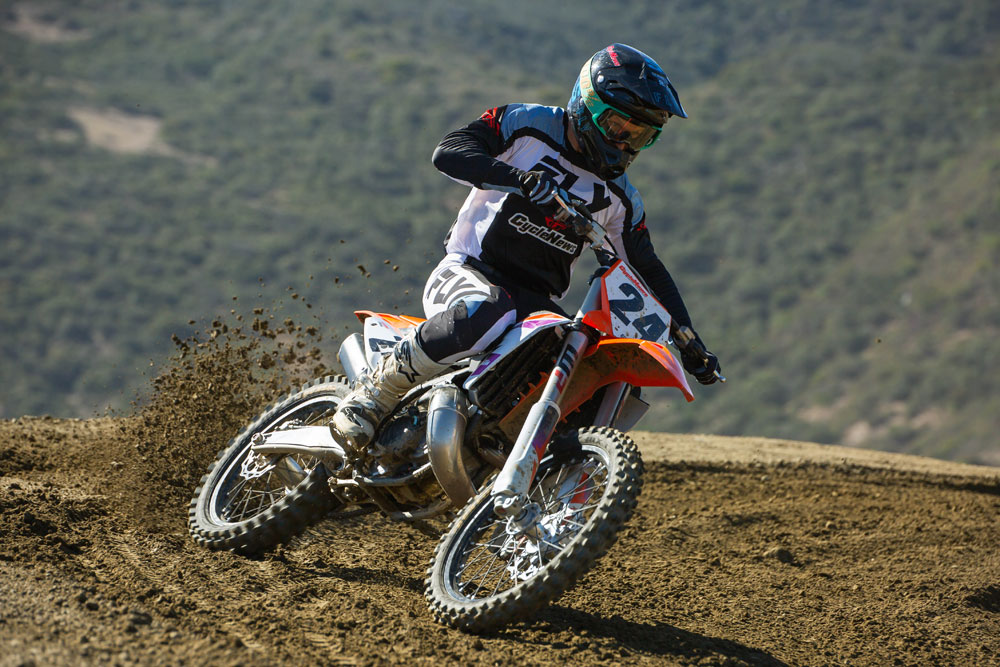 If horsepower matters most to you, then you will like the KTM two-stroke.
If horsepower matters most to you, then you will like the KTM two-stroke.
KTM Four-Stroke
Like the two-stroke, the SX-F underwent an extensive redesign in 2023, so updates for this year are minimal. A new engine design, frame, swingarm, bodywork and suspension were big talking points on all the new-gen KTMs, the 250 SX-F included. The electronic suite on the four-stroke offers traction control and quick shift capabilities on top of the dual-map options. Notably, the SX-F also gained more than five pounds during this overhaul, bumping it out of its long-standing title as the “lightest bike in the class.” The 250 SX-F houses 47 horsepower at 238 pounds and hits dealerships with a price tag of $10,199.
On paper, the two-stroke SX looks better in every aspect. It’s five pounds lighter, packs six extra horses, and is more than $1000 cheaper. For our two-stroke die-hards, the story might end there. But spec sheets and dyno charts aren’t what win these kinds of comparisons.
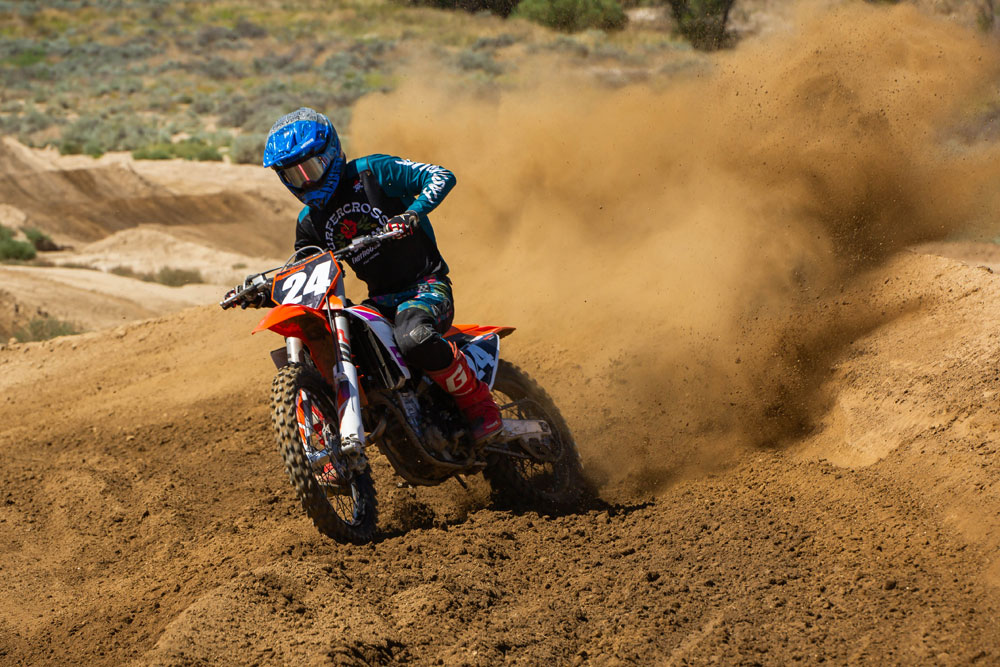 The SX-F feels more planted to the ground than the SX.
The SX-F feels more planted to the ground than the SX.
KTMs Head-To-Head
The 250 versus 250F debate is still a hot topic. In some organizations, the 250 class is just that, a class for 250cc machines regardless of their strokes. The bigwigs in the premier AMA events, like Supercross and Pro Motocross, don’t see it the same way, as the 250 two-stroke is forced to compete against the larger-displacement 450cc four-stroke machines. For reference, KTM claims more than 63 horsepower for their current 450 motocrosser. That’s 10 more than the stock 250 SX. Some agree with this ruling, others don’t. We favor the straight-up 250 rule as each machine has benefits and drawbacks.
The KTM Engines
The two-stroke is faster. There, we said it. It’s no secret that the six extra horses are apparent when you take to the track. The 250’s new TBI design is much smoother and easier to ride than any other two-stroke we can remember. It’s as four-stroke as a two-stroke can get. Initial roll-on is consistent, and there’s no hesitation or bog upon the first crack of the throttle. Like we said before, this is not Dad’s two-stroke. The exciting hit that you’d find on a carbureted machine is nearly gone, and some of our riders said the 250 SX is less “exciting” to ride than a classic carbed bike.
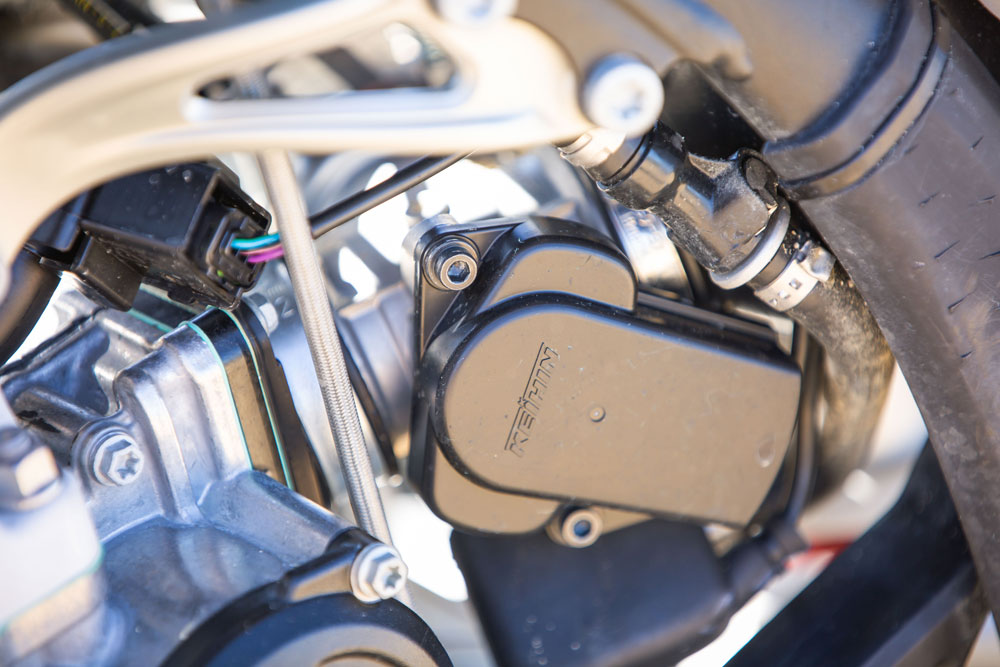 The KTM 250 SX’s new fuel-injected motor provides more useable power.
The KTM 250 SX’s new fuel-injected motor provides more useable power.
On the other hand, the vet riders favored it for lug-ability and down-low torque. It all but makes up for that in overall versatility, as riders no longer need to fiddle with jets or tuning for altitude. You can still scream it around like the two-strokes of old, but the off-the-bottom torque is undoubtedly a helping hand.
While the two-stroke arguably wins the engine category, it does have some shortcomings. The smoker excels in deep conditions like sand or loam. Just turn on the aggressive map, aim for the outside of the corners, and enjoy the ride! But it’s a different story on hard-packed tracks. The engine feels ultra-touchy and requires the rider to be mindful of the throttle-hand motion. Throttle control is critical on the two-stroke. This is nothing new in terms of two-stroke technique, but it seems exaggerated on the new KTM. Overall, power also dies out too soon as the SX. The power is strong but only in a small window from the bottom to mid, as it lacks much of its old over-rev character.
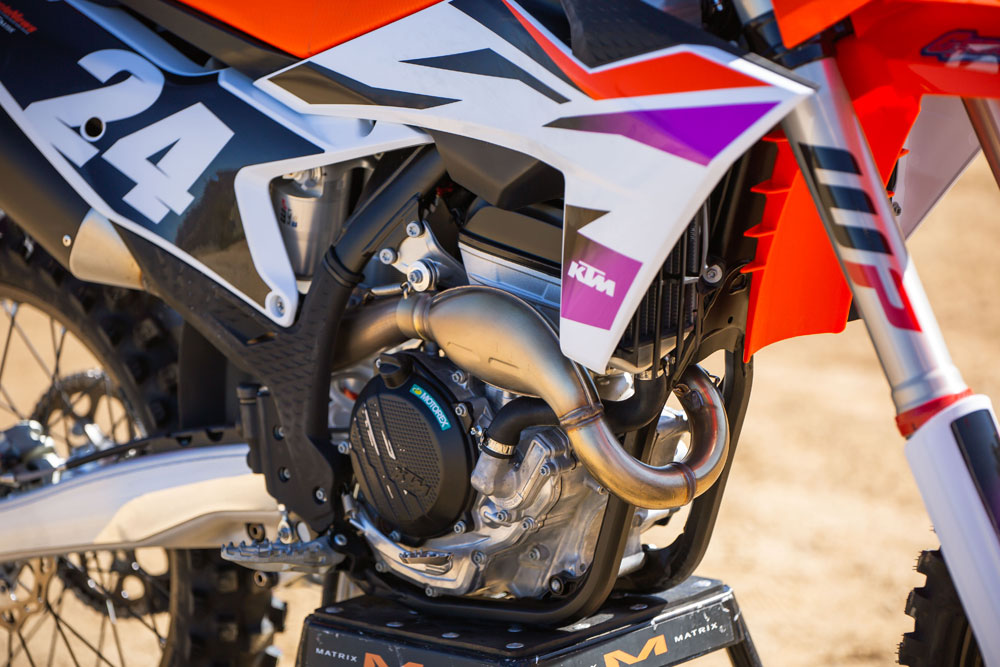 Still, it’s hard to touch the SX-F’s more user-friendly power delivery.
Still, it’s hard to touch the SX-F’s more user-friendly power delivery.
What the four-stroke lacks in overall power output is made up in usability. The consistent feel of the SX-F reminds you why four-strokes virtually took over the world. KTM’s new engine design prioritizes down-low torque and is a different personality than the ultra-high-revving motors in previous generations. It’s much more vet or novice-friendly and transitions into a strong mid-to-top character that can be ridden near its full potential by an intermediate-level rider. A one-lap heater might be quicker on the two-stroke, but the four-stroke strings together consistently fast laps late into the moto without thinking twice about ideal track conditions.
KTM Suspension / Chassis
These two bikes share most of the same suspension and chassis components. WP Xact forks and shocks suspend both of the central double-cradle steel frames. However, the feeling on each bike is a stark contrast. The two-stroke, while lighter, feels less stable than the four-stroke competitor, primarily upon corner entry. The weight of the four-stroke plays to its favor here as the bike is more planted, and riders felt they could trust the front end much more on the SX-F. Overall maneuverability is easier on the two-stroke as it feels lighter on track and in the air, but you’ll likely opt for a fluffy outside line rather than putting faith into a steep lean angle. The SX-F can hit any line at any time and requires less effort.
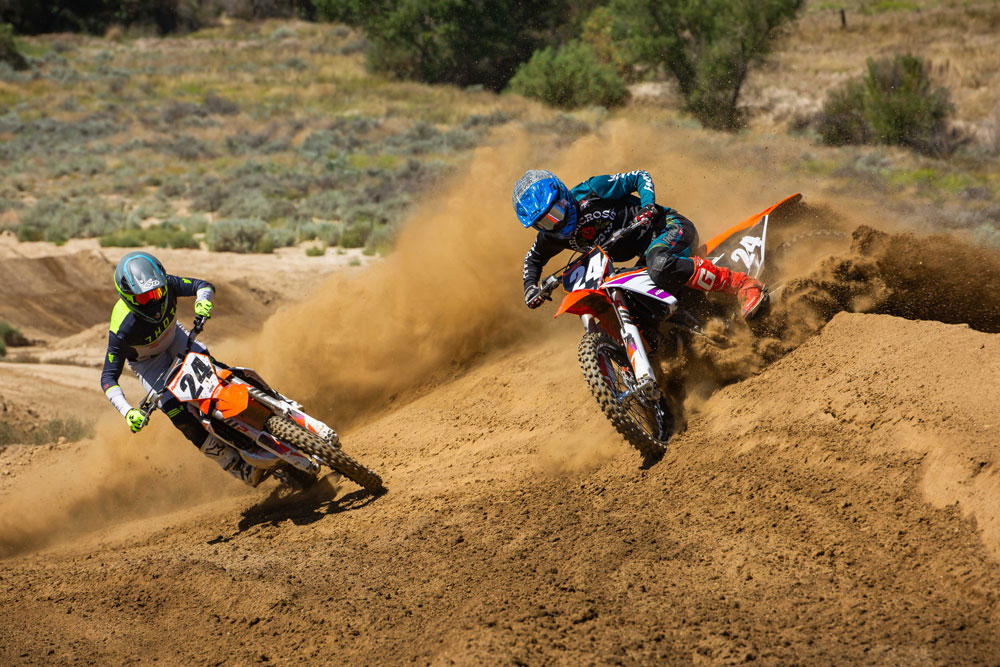 The overall performance gap between the KTM 250 SX two-stroke and KTM 250 SX-F four-stroke has narrowed considerably.
The overall performance gap between the KTM 250 SX two-stroke and KTM 250 SX-F four-stroke has narrowed considerably.
Other Similarities
KTM specs both of their 250 motocrossers with many of the same parts. You’ll find Neken handlebars, ODI grips, Brembo clutches and brakes, and Dunlop tires on both bikes. The bodywork, seats and footpegs are also identical. These similarities make jumping from one bike to another easy, especially if you have more than one in your fleet.
2024 KTM 250 SX vs. KTM 250 SX-F | Wrap Up
Two things were evident when the checkers flew on this test. The two-stroke SX is faster yet “harder” to ride. And hard is relative—it requires more effort to maintain speed throughout a moto. Looking for lines, feathering the clutch, and maintaining throttle control are all non-negotiables on the 250 SX. The four-stroke might lose on paper, but we deemed it easier to ride for the same duration. Searching for lines isn’t as crucial, and the bike feels more consistent in every condition. Riders use less brain power when repeatedly hitting their marks lap after lap on the four-stroke. Factoring in base prices and rebuilds further deepens this debate.
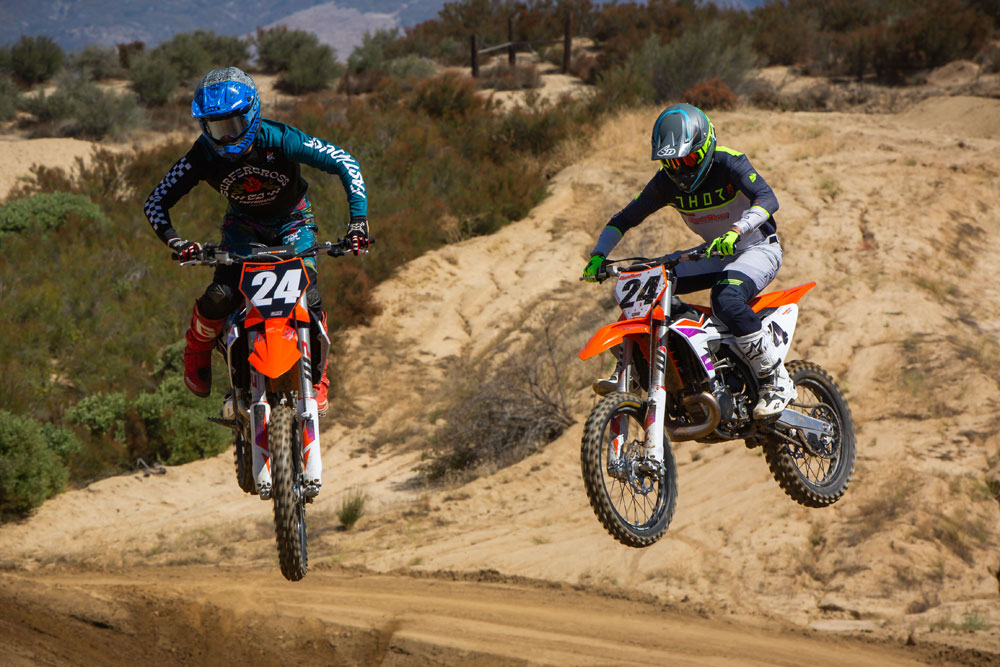 We thank KTM for still giving us two choices.
We thank KTM for still giving us two choices.
Is there a clear-cut winner? Not necessarily. Depends on what your priorities are, mainly between fun and performance. Our testers felt they could go faster for a longer period on the SX-F four-stroke. However, that doesn’t mean it was as fun. The two-stroke SX easily takes the cake in the smiles-per-hour category but requires riders to eat their Wheaties before jumping aboard. Until the pro-level rules change, we’ll continue enjoying both 250 machines. CN
VIDEO | 2-Stroke vs. 4-Stroke!
2024 KTM 250SX or 250SX-F?
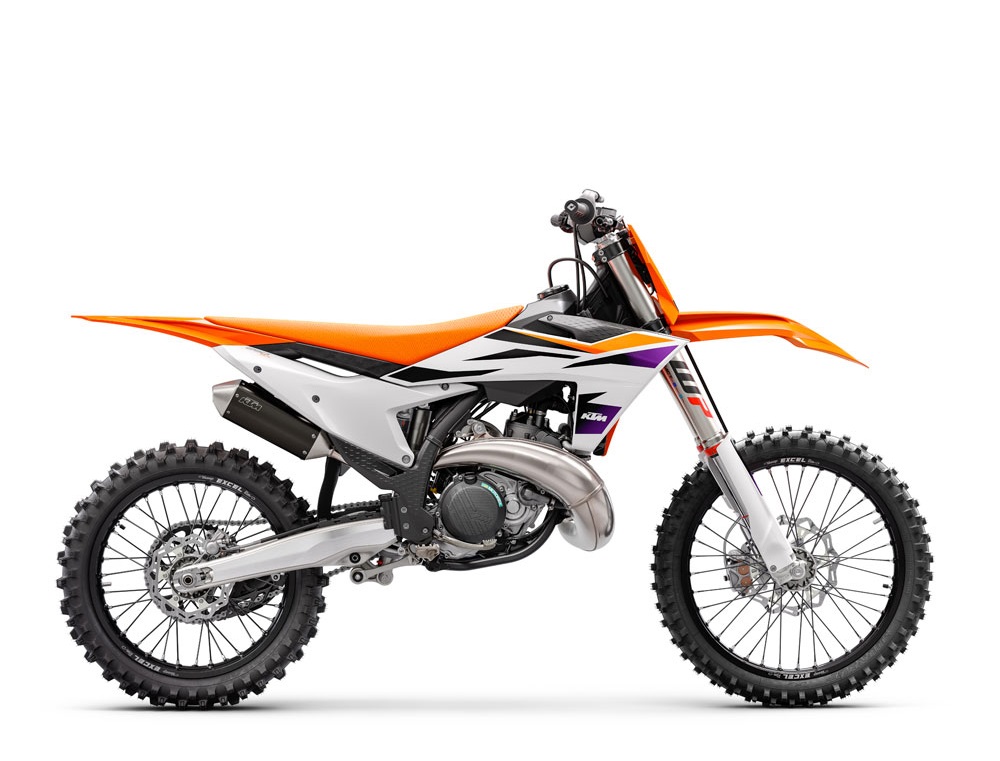
2024 KTM 250 SX Specifications
| MSRP: |
$9149 |
| Engine Type |
2-stroke, single |
| Cooling System |
Liquid |
| Displacement |
249cc |
| Bore x Stroke |
66.4 x 72mm |
| Starting System |
Electric |
| Fueling |
Vitesco Technologies EMS |
| Transmission |
5-speed, w/ hydraulic Brembo clutch |
| Frame |
Central double-cradle-type 25CrMo4 steel |
| Subframe |
Polyamide |
| Handlebar |
Neken aluminum |
| Front Suspension |
WP Xact 48mm |
| Rear Suspension |
WP Xact Monoshock with linkage |
| Front-Wheel Travel |
12.2 in. |
| Rear-Wheel Travel |
11.8 in. |
| Front Wheel |
21 in. |
| Rear Wheel |
19 in. |
| Front Brake |
Brembo 260mm |
| Rear Brake |
Single 220 mm, Brembo caliper |
| Steering Head Angle |
63.9° |
| Seat Height |
37.7 in. |
| Ground Clearance |
14.1 in. |
| Fuel Capacity |
1.9 gal. |
| Weight (curb, actual) |
233 lbs. |
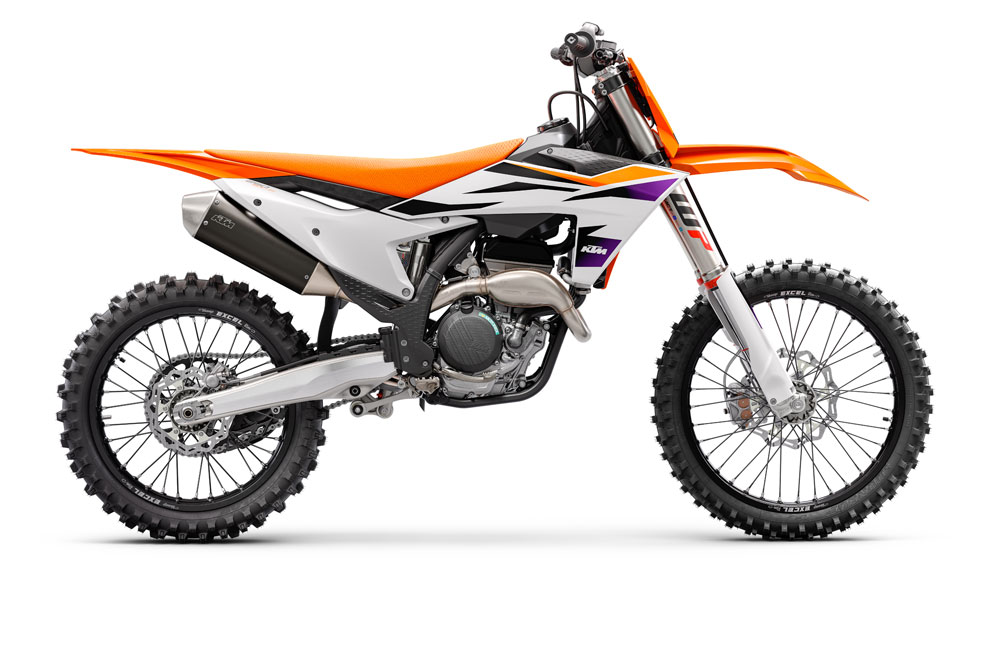
2024 KTM 250 SX-F Specifications
| MSRP: |
$10,199 |
| Engine Type |
4-stroke, single |
| Cooling System: |
Liquid |
| Displacement |
249.9cc |
| Bore x Stroke |
81 x 48.5mm |
| Starting System |
Electric |
| Fueling |
Fuel Injection with Keihin EMS |
| Transmission |
5-speed, w/ hydraulic Brembo clutch |
| Frame |
Central double-cradle-type 25CrMo4 steel |
| Subframe |
Polyamide |
| Handlebar |
Neken aluminum |
| Front Suspension |
WP Xact 48mm |
| Rear Suspension |
WP Xact Monoshock with linkage |
| Front-Wheel Travel |
12.2 in. |
| Rear-Wheel Travel |
11.8 in. |
| Front Wheel |
21 in. |
| Rear Wheel |
19 in. |
| Front Brake |
Brembo 260mm |
| Rear Brake |
Single 220mm, Brembo caliper |
| Steering Head Angle |
63.9° |
| Seat Height |
37.7 in. |
| Ground Clearance |
14.1 in. |
| Fuel Capacity |
1.9 gal. |
| Weight (curb, actual) |
238 lbs. |
